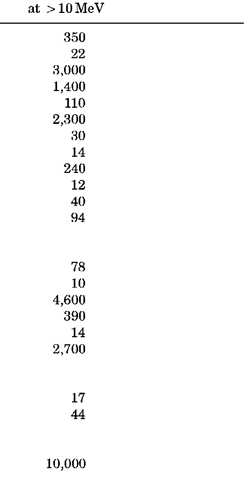Although many cultures deified the Sun, for example, Ra, the Egyptian sun god, and SURYA, the sun god in Ancient India, humans became aware of its real significance to terrestrial beings only in the last 400 years. Before the Copernican heliocentric model of the solar system was accepted, the Sun and the ”wandering stars” (which we now know are planets), the Moon and the fixed stars were objects whose apparent daily motions needed to be explained. The Ptolemaic system hypothesized intricate moving equants and epicycles to describe the motion. By placing the Sun logically at the center of the solar system and observing moving spots on the Sun, Galileo established its place in our current world view. Contemporary humans have learned that the Sun supplies a nearly constant flux of visible radiant energy to Earth and is also magnetically connected to it so that powerful releases of energy at a distance of 1 AU (1.5 x 108km or ~93 million miles) from Earth can produce surprisingly large local effects, such as the extensive power failure in October 1989. Basic Properties Of the Sun. The Sun is only one of several billion stars in our galaxy, but as a special example, it is important to understand how it compares to other stars. Following the development of stellar spectroscopy, techniques became available to classify stars by their locations on the Hertzsprung-Russell (HR) diagram, which is a plot of stellar luminosity as a function of spectral type. Figure 1 from Chaisson and McMillan (1) shows an HR diagram for several varieties of stars. The ordinate is the object’s optical luminosity or the total energy emitted per second by the object, and the abscissa is the star’s spectral type, which is a measure of its surface temperature. To place a star on the HR diagram, the star’s distance must be known, so its absolute luminosity can be determined from the measured luminous flux using the inverse square law. As in Fig. 1, the luminosity is usually expressed in terms of the Sun’s luminosity. The star’s spectral type is determined by measuring the star’s ”color” and characterizing its spectrum. The sun is a ”G” class star. Stars that have higher surface temperatures, for example, are ”O” class, and ”M” class stars have lower surface temperatures. All normal stars span a temperature range from ~ 40,000 K to ~4000K. Actually a star’s spectral class is determined by comparing its spectrum with the spectra of a set of standard stars. Some physical properties of the Sun and the way the properties are determined are shown in Table 1 (from Reference 2).
Of most interest here is the group of stars on the main sequence, the so-called ”normal stars,” that are in the early stages of their evolution. (The Sun is indicated by the symbol ©.) Formally, the Sun’s spectral class is G 2 V, and its surface temperature is ~ 6000 K. It is considered an average main sequence star in all respects: luminosity, surface temperature, and size. The M class stars are typically 0.1 times smaller than the Sun, and the O class stars are 100 times larger than the sun. However, due to the sun’s proximity to us, detailed studies of it and the radiations it emits can be done with great precision, and this knowledge can be used to understand other stars better.
From direct measurement of isotope ratios, we know that the Sun’s age is ~4.5 billion years, and from the theory of stellar evolution, that it may live at least another 5 billion years. When its current internal energy source is depleted, it will expand and become a red giant and eventually a dwarf star similar to those on the HR diagram in Fig. 1. As far as its origin is concerned, the Sun and planets may have formed as a result of a supernova explosion near the early solar nebula. This aspect of the Sun’s early life and its future are fascinating topics (see, for example, Reference 3), but our goal here is to describe the present Sun in some detail.
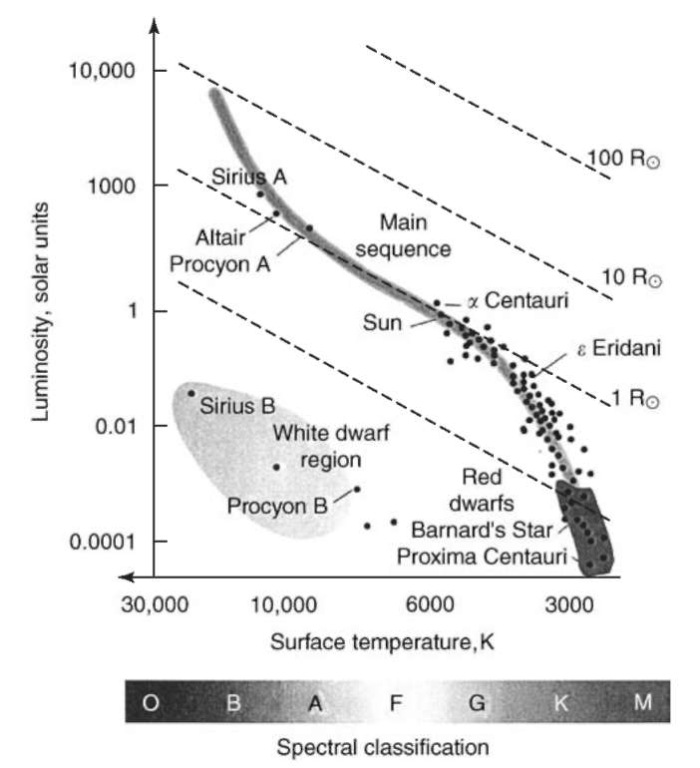
Figure 1. Most stars have properties within the shaded region known as the main sequence. The points plotted here are for stars lying within about 5 pc of the Sun. The diagonal lines correspond to constant stellar radius, so that stellar size can be represented on the same diagram as luminosity and temperature. (Recall that O stands for the Sun.) From Reference 1.
The current understanding of the Sun draws on advances in both ground-based observing techniques and sophisticated space instrumentation, as well as in theoretical computer models using the observations as input. This review first briefly describes some important ground-based observations and identifies several space missions whose main purpose has been to advance our knowledge of our nearest star. Next, the structure of the Sun and its atmosphere is described in more detail, beginning at the center of the Sun and emphasizing our current understanding in appropriate detail. A major goal of this work is to give an up-to-date summary of our knowledge of solar activity. The new science of helioseis-mology is discussed later, and space weather, as it affects Earth, is also covered briefly later. For each topic, a brief history will be given with a summary of current knowledge followed by identification of important unsolved problems. References for further study will be given for each topic discussed. A general reference for the topics discussed can be found in chapter 16 of Astronomy Today by Chaisson and McMillan (1).
Table 1. Properties of the Suna
| Datum | How found | Value |
| Mean distance Maximum distance to Earth |
Radar reflection from planets | 1AU 149,597,892 km 1.521 x 108 km |
| Minimum distance to Earth |
1.471 x 108 km | |
| Mass Mean angular diameter |
Acceleration of Earth Direct measure | 333,400 Earth masses 1.99 x 1033g 31′ 59″.3 |
| Diameter of photosphere Mean density | Angular size and distance Mass/volume | 109.3 times Earth diameter 1.39 x 1011cm 1.41 g/cm3 |
| Gravitational acceleration at photosphere (surface gravity) Solar constant Luminosity Spectral class |
GM/R2 Measure with instrument such as bolometer Solar constant times area of spherical surface 1 AU in radius Spectrum |
27.9 times Earth surface gravity 27,300 cm/s2 1.9cal/min/cm2 21.368 x 106ergs/s/cm2 3.8 x 1033ergs/s G2V |
| Effective temperature | Derived from luminosity and radius of Sun | 5800 K |
| Visual magnitude Apparent Absolute |
Received visible flux Apparent magnitude and distance | - 26.7 + 4.8 |
| Rotational period at equator | Sunspots and Doppler shift in limb spectra | 24d16h |
| Inclination of equator to ecliptic | Motions of sunspots | 7°10′ .5 |
Ground-Based Observations of the Sun. Heracleides (388-315 b.c.) and Hipparchus (190-120 b.c.)1 can be considered the first who observed the Sun with a scientific motivation. The Ptolemaic Earth-centered system, as promoted by Aristotle, held sway until Copernicus (1475-1543) proposed the heliocentric model for the solar system, even though Aristarchus (~ 320 ~250 b.c.) had earlier considered such a model. However, serious study of the Sun began after Lip-persheim invented the telescope in 1608. Galileo (1610) in Padua and Fabricius (1610) in Wittenberg used it in their independent discoveries of sunspots. Solar physics investigations for the next 192 years consisted of recording the number of sunspots on the solar disc until 1802 when Wollaston discovered dark lines in the solar spectrum. Using an improved spectrograph, Fraunhofer discovered 547 additional dark lines, features that were named after him. The origin of these strange features on the Sun, as explained in 1859 by Kirchhoff and Bunsen, is the selective absorption of light from the hot solar surface that is directed toward Earth, by the cooler atoms in the Sun’s atmosphere. By 1929, the chemical composition of the Sun was known as a result of the pioneering work of Hale and Russell and many others. That the Sun rotates in a period of about a month was first inferred from the observation of sunspots. A more complete summary of the knowledge of the Sun’s properties, obtained before the era of space age astronomy, can be found in several readable texts such as Menzel (4) and Kiepenheuer (5). Early Solar Physics by Meadows (6) contains an interesting review of ideas about the Sun in the period 1850-1900 and has several original papers. Hufbauer (7) traces the development of knowledge about the Sun from Galileo’s time.
Space-based observations of the Sun are complemented by very significant ground-based observations. From the latter group, we discuss the following:
* The discovery of radio emissions from the Sun in 1942 during the development of radar, which led to the study of solar radio bursts by using radio-heliographs.
* The discovery of neutrinos from the Sun whose flux was significantly below theoretical expectations; this discrepancy is driving a revision of our understanding of stellar interiors and also fundamental particle physics. [See notes added in proof.]
* The development of helioseismology, beginning with the discovery of 5-minute oscillations of the Sun in 1960, which led to the development of the Global Oscillation Network Group (GONG) project, the Michelson Doppler Imager/Solar Oscillation Investigation (MDI/SOI), and, the Extreme-Ultraviolet Imaging Telescope (EIT) instruments on the Solar and Heliospheric Observer (SOHO) satellite.
Observations Of the Sun from Space. Table 2 is a chronological list of the principal space missions, which have, or are expected to, provide significant advances in our knowledge of the Sun. Here we give a brief summary of the main facets of the Sun that a given mission is intended to study. In the following sections, we describe in more detail some of the observations or discoveries made on these missions.
Table 2. List of Space Missions Relevant to Solar Physics*
| Mission name | Launch date | Termination date |
| Sounding rockets | 1946 | Continuing |
| Vanguards | 1959 | |
| Solrads | 20 June 1960 | 1975 |
| Orbiting Solar Observatories (OSO) | 1962 | 1975 |
| Mariner 2 | 27 August 1962 | 14 December 1962 |
| Skylab | 1973 | 1974 |
| Helios 1 | 1974 | 1984 |
| Helios 2 | 1976 | 1981 |
| ISEE3/ICE | 1978 | 1982 |
| P78-1 | 1978 | 1985 |
| Solar Maximum Mission (SMM) | 14 February 1980 | 3 December 1989 |
| Hinotori | 21 February 1981 | |
| Space Shuttle | 1982 | Continuing |
| GRANAT | 1 December 1989 | 1974 |
| Ulysses | 6 October 1990 | Continuing |
| Gamma-1 | 1991 | |
| Compton Gamma-Ray Observatory (CGRO) | 5 April 1991 | 4 June 2000 |
| YOHKOH | 30 October 1991 | Continuing |
| Solar and Heliospheric Observer (SOHO) | 2 December1995 | Continuing |
| Advanced Composition Explorer (ACE) | 25 August 1997 | Continuing |
| Trace | 2 April 1998 | Continuing |
The first observations of the Sun from space were made by Naval Research Laboratory (NRL) scientists in 1946 using ultraviolet (UV) and X-ray spectrometers carried on V-2 rockets captured from the German military in 1945. Further observations were made of solar UV and X-ray emissions using Viking and Aerobee rockets. After 1980, Black Brant rockets were used as well as the Aries and the second stage of the Minuteman I ICBM. Sounding rockets of various types are still used today to obtain—mainly UV, extreme UV (EUV), and X-ray spectra of the Sun using precise imaging telescopes. Sometimes, sounding rocket instruments are used for cross-calibration of instruments carried on satellites such as SkyLab or the Solar Maximum Mission. (A discussion of some of the early results is given in Reference 8.)
The first satellite observations of solar Lyman alpha (1216 A or 121.6 nm) and soft X rays (1-8 A or 10-80 nm) were made by NRL from SolRad I during a period of 5 months after launch on 10 June 1960. Additional SolRad satellites produced continuous data on UV and soft X rays through 1975.
Starting in 1962, NASA launched its Orbiting Solar Observatory (OSO) Series, which made many important observations of the quiet and active Sun through 1975. The first white light coronagraph and high-resolution gamma-ray spectrometer were flown on OSO 7, launched in 1971 and operated for 15 months.
During its 4-month journey to Venus in 1962, Mariner 2 made comprehensive and definitive observations of the solar wind.
Following OSO 7, the SkyLab (the last phase of the manned Apollo program) was launched in 1973 and continued into 1974. Imaging soft X-ray and EUV telescopes made pioneering observations related to the solar wind (SW) and coronal holes. (See also Reference 9 for a brief review of early results from the SolRads, OSOs, and SkyLab.)
From 1974 to 1976, the European Helios 1 and 2 solar-orbiting satellites made plasma and high-energy electron and ion observations at distances from the Sun as close as 0.3 AU.
From 1978 to 1982, the International Sun Earth Explorer 3 (ISEE3) was at the Sun-Earth Lagrangian point (L1) and made numerous valuable solar flare observations. As the International Comet Explorer (ICE), it continued flare observations beyond 1982.
In 1978, the U.S. Air Force launched the P78-1 satellite that carried a white light coronagraph (Solwind) and observed many coronal mass ejections (CMEs). In the early 1980s, the P78-1 mission unceremoniously ended when it became a target in a ”Star Wars” test.
On 14 February 1980, the Solar Maximum Mission (SMM) satellite was launched. It carried six instruments for a coordinated study of solar flares, at the maximum of sunspot cycle 21, covering several spectral regions: the UV, soft and hard X rays with the hard X-ray burst spectrometer (HXRBS), and gamma rays, with the gamma-ray spectrometer (GRS). The instrument payload included a cavity radiometer for measuring the total solar luminosity or ”solar constant.” In April 1984, SMM was taken onboard the space shuttle Challenger to replace gyroscopes and to refurbish some instruments. SMM was returned to orbit and made important flare observations during the rising phase of sunspot cycle 22. Its mission was ended on 2 December 1989 by orbital decay caused by expansion of earth’s atmosphere due to heating from solar UVand X-ray emissions, the very radiations it was designed to study! Early results from all SMM instruments are described in a report of an SMM workshop (10).
The Japanese Hinotori solar-observing satellite, launched on 21 February 1981, made many observations of solar flares, some of which overlapped SMM/ GRS observations. (A review of high-energy solar flare observations during this period is given in Reference 11.)
In 1982, the manned Space Shuttle program began. Several small special-purpose solar observations were made from the SPARCS satellites, which were developed earlier for sounding rocket flights. SPARCS was deployed during a 7 to 10-day mission by shuttle astronauts, coorbited with the shuttle, and then was retrieved at the end of mission. It was returned to Earth, and a new solar instrument was installed, ready for another shuttle launch. The major Shuttle mission of importance to solar physics was the launch of Spacelab 2 on 29 July 1985. Spacelab 2 carried three solar telescopes and several other instruments with two solar physicists, Loren Acton and John-David Bartoe, to operate the solar telescopes. (See Reference 12 for a complete history of the Spacelab program.)
The Russian Granat satellite was launched in December 1989 carrying the French/Russian SIGMA, a new type of imaging gamma-ray telescope and a scintillator gamma-ray spectrometer, PHEBUS, that responded omnidirectionally. Therefore, PHEBUS could detect many gamma-ray flares, but not with the same efficiency as the SMM/GRS.
In October 1990, the ESA Ulysses was launched. Its mission is to study the high-latitude heliosphere, that is, above and below the plane of the ecliptic. It also carried instruments to study the solar wind composition and charge state and an X-ray spectrometer to study solar flares. A review of the results from the first orbit of Ulysses around the Sun was presented by Reference 13.
The Russian spacecraft GAMMA-1, operational during 1991, made valuable observations of two high-energy flares.
On 5 April 1991, the Compton Gamma-Ray Observatory (CGRO) was launched. Its primary mission was to study cosmic sources of gamma rays with four instruments, which covered the photon energy range from a few keV to 30 GeV. However, as a secondary goal, all CGRO instruments can make solar flare observations and have made some significant discoveries. On 3 June 2000, CGRO underwent a controlled reentry over the Pacific Ocean to reduce the chance of debris impacting populated areas.
The Japanese YOHKOH solar-observing satellite, launched on 31 August 1991, carried the soft and hard X ray imaging telescopes (SXT) and (HXT). The dramatic imaging capabilities of the SXT and HXT have revolutionized the study of solar activity.
On 2 December 1995 the Solar and Heliospheric Observer (SOHO) was launched with 12 instruments for studying several phenomena of the quiet and active sun. Helioseismology, solar wind (SW) and coronal mass ejection (CME) observations from SOHO are discussed in individual sections later.
The Advanced Composition Explorer (ACE), launched on 25 August 1997, is designed to study solar flare particle emissions, cosmic rays, the SW, and other heliospheric energetic particle phenomena. It is positioned between the Sun and Earth at the Sun/Earth neutral gravity point, L1. (For solar flare particle emissions, see the section on Space Weather, in this article.)
The Transition Region and Coronal Explorer (TRACE) was launched on 2 April 1998 to image (to 1arcsecond spatial resolution) the photosphere, the transitional region, and the corona at three EUV wavelengths and several UV wavelengths. The solar plasma can be studied at selected temperatures from 6000 K to 107 K.
STRUCTURE OF THE SUN
The structure of the Sun is illustrated in Fig. 2 as a series of concentric spherical shells, or zones, which are understood to have different physical characteristics, as deduced from observations and the theoretical development of the standard


Figure 2. A schematic of the Sun showing the relative location of various regions and their approximate thicknesses. Not drawn to scale. From Reference 1.
temperature of ~ 5800 K. These zones lie within the Sun’s visible disk as measured at a wavelength of 500 nm, although we see only the photosphere. Figure 3, from Reference 15, shows the internal physical properties of the Sun predicted by the SSM. A new means of studying the interior of the Sun uses helioseismology techniques on the SOHO satellite that complement the GONG observations.
Above the photosphere lies the solar atmosphere that has three distinct regions: the ”cool” chromosphere (~4500K) ~1.5 x 103km thick, sometimes called the color sphere and seen in some total eclipses followed by the transitional region ~ 8500 km thick in which the temperature rises rapidly to ~8000K, and then the low-density, hot corona at a temperature of ~1 x 106km, also seen in a total eclipse. The expansion of the corona into the interplanetary medium (IPM) becomes the solar wind, which extends throughout the solar system.
The Core and the Neutrino Problem. It was realized in the mid-1800s that if the source of the Sun’s energy was due to its gravitational contraction, the so called “Helmholz-Kelvin hypothesis,” then the Sun could not have existed longer than ~3 x 107 years. However, by the 1930s, age dating of terrestrial rocks containing radioactive minerals indicated that they had existed for ~1.6 x 109years., so clearly gravitational energy is inadequate to account for the existence of the Sun and, in fact, all stars on the HR main sequence. That transmutation of elements might be a source of stellar energy was considered as early as 1920 by Eddington and others (see Reference 16). Numerous authors investigated the energy release from possible nuclear reactions, but a paper by Bethe in 1939 (17) provided details for the fusion, or nuclear burning, of hydrogen to helium via the CNO cycle and the p-p chain. These two pathways for producing the Sun’s energy are shown in Table 3, although there are three alternative p-p chains. The basic CNO cycle, in which the heavy elements act only as catalysts, was suggested in 1938 independently by Bethe and von We-izsaecker. These reactions convert four hydrogen atoms into one helium nucleus

has been suggested. A direct experimental proof that the nuclear burning is currently in progress seems to have been presented now (see later and note added in proof).
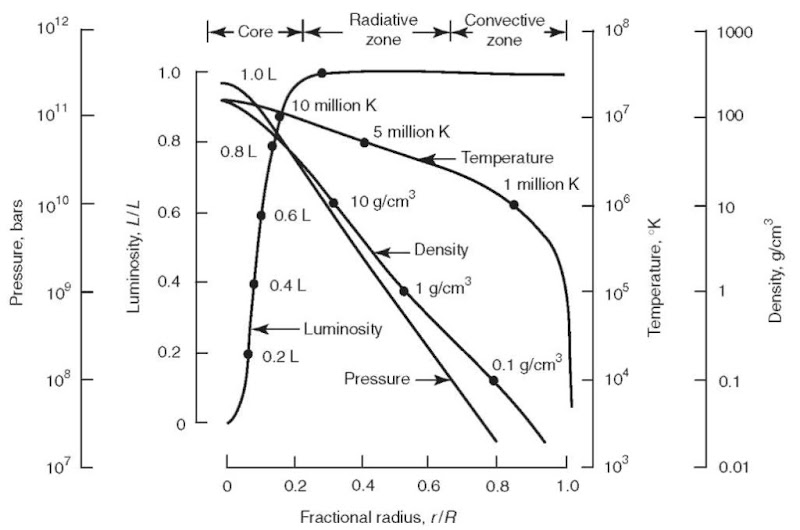
Figure 3. Internal compression. The variation of pressure, luminosity, temperature, and density with fractional radial distance from the Sun’s center (left) to its visible surface (right). At the Sun’s center, the temperature is 15.6 million Kelvin, and the density is 151 grams per cubic centimeter; the central pressure is 233 billion times that of the Earth’s atmosphere at sea level (one bar). Thermonuclear energy is produced in a core region that extends to about one-quarter (0.25) of the solar radius; the core contains almost half of the Sun’s mass. The convective zone begins at 0.71 of the solar radius where the temperature has dropped to about 2 million Kelvin and the density has fallen to about 0.2 grams per cubic centimeter; the convective zone comprises about 2% of the Sun’s mass. In the photosphere, the temperature is 5780 Kelvin, and the pressure and density have dropped off the scales of the graph.
Table 3. The pp Chain and the Carbon-Nitrogen Cyclea

Because the weak interactions in the p-p chain produce neutrinos, it was clear (see e.g., Reference 18 and 23) that detecting them with a flux consistent with theoretical predictions could confirm that nuclear fusion reactions were the source of the Sun’s energy. All of the reaction cycles shown in Table 3 produce neutrinos, but these were not all considered in the early papers about nuclear fusion as the source of stellar energy (see, e.g., Reference 17). The net result of hydrogen burning is 41H — 4He + 2e + + 2ve. Because the theory of beta decay was untested (the neutrino was not observed until 1956 at the Oak Ridge nuclear reactor), Pontecorvo (in 1946) and Alvarez (in 1949) proposed detecting neutrinos by the reaction 37Cl(ne,e ~ )37Ar. However, the possibility that (the expected) solar neutrinos could be detected eventually led Davis to develop a large neutrino detector consisting of ~ 100,000 gallons of cleaning fluid (CCl4).2
A history of the development of this neutrino detector, other experimental possibilities, and related theoretical work is described well by Bahcall and Davis (19). To understand how this detector relates to the neutrinos produced by nuclear fusion, according to the Standard Solar Model (SSM), Bahcall and Shaviv (20) had deduced the neutrino flux at Earth versus the energy of the neutrinos from the different reactions shown in Table 3 before the first results from the chlorine detector had been reported. As can be seen in Fig. 4, from Bahcall (21), the chlorine detector can respond to all neutrinos whose energies are above 0.814 MeV, which can come from 8B, from electron capture by 7Be, or from the rare proton-electron-proton (pep) reaction.

Figure 4. Solar neutrino spectrum. This figure shows the energy spectrum of neutrinos predicted by the standard solar model. The neutrino fluxes from continuum sources (like pp and 8B) are given in the units of number per cm2 per second per MeV at one astronomical unit. The line fluxes (pep and 7Be) are given in number per cm2 per second. The spectra from the pp chain are drawn with solid lines; the CNO spectra are drawn with dotted lines. The upper abscissa scale shows the energy range, from threshold, to which three types of neutrino detectors are sensitive.
The chlorine detector has been operated, from 1967 to 1993, in the Home-stake gold mine in South Dakota. The first results from the chlorine detector (22) showed that the CNO cycle produces less than 9% of the Sun’s energy. Later results are shown in Fig. 5, a plot of the measured flux of neutrinos from late 1986 to late 1992 (23). The average value of the measured neutrino flux was

iment or the SSM and basic neutrino physics wrong?
This question and results from three new neutrino experiments, in addition to the Davis results, are discussed in Bahcall (21). Because all of the experiments disagree with the theory, three solar neutrino problems are identified. The discrepancy between the chlorine result and theory is the ”first” solar neutrino problem. Now, as shown in Fig. 4, neutrinos whose energy is higher than 7.5 MeV from 8B decay can be detected by neutrino-electron scattering. Such a reaction can be detected by the Kamiokande II (K II) 4500-ton pure water detector, that records the (Cherenkov) light in a large array of photomultipliers from electrons knocked out of H2O molecules by neutrinos. After 1000 days of operation, this experiment reported in 1991 a neutrino flux of 0.44 + 0.06 SNU, about 2.5 times below the predicted value of 1.0^0()1147 SNU. So both experiments confirm a deficit in the expected solar neutrino flux. However, the chlorine and Kamiokande results are incompatible with one another, and Bahcall identifies this as the “second” solar neutrino problem (see the left and central bar graphs in Fig. 6).
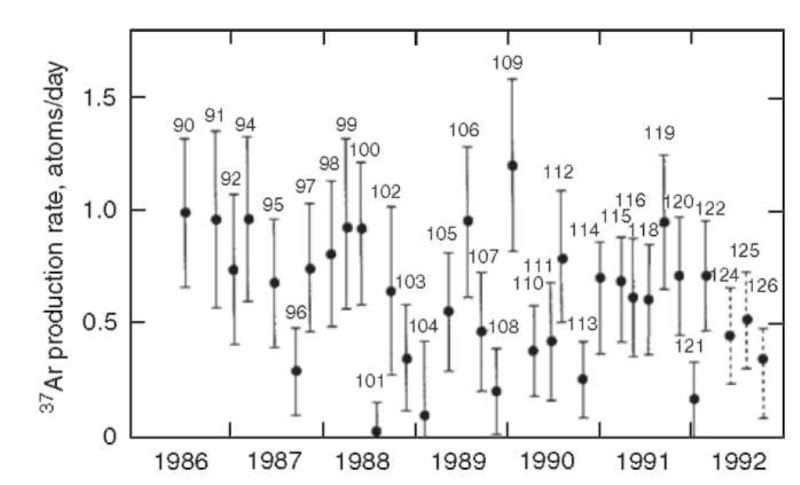
Figure 5. A plot of the 37Ar production rates versus time. This plot summarizes the data obtained after the Homestake experiment resumed operation in September 1986. Run numbers are shown above each plotted point. Not plotted are run 93 for SN1987A and run 117 for the solar flare of 4 June 1991.
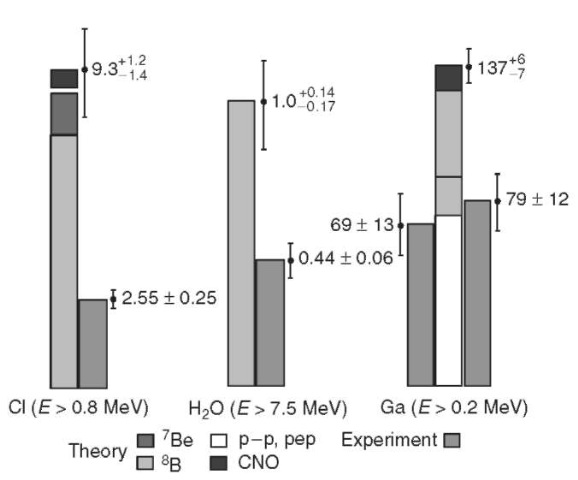
Figure 6. Comparison of measured rates and standard model predictions for four solar neutrino experiments.
The SAGE and GALLEX experiments use gallium as the detector and can detect neutrinos whose energies are > 0.2 MeV. The average for the gallium experiments is 74 SNU, but a rate of 137+76 SNU is expected (bar graph on the right in Fig. 6). This conflict is the “third” neutrino problem. (”As far as the theoretical predictions are concerned, several teams have developed computer codes for predicting the current neutrino flux and, when using the same input data, obtain results that agree to within a few percent”) (see Reference 24). Bahcall (21) also concludes ”that at least three of the four operating solar neutrino experiments give misleading results or else physics beyond the standard electroweak model is required to change the neutrino energy spectrum (or flavor content) after neutrino production.”
Earlier, Bahcall and Bethe (25) argued that the SSM is valid and that any nonstandard solar model consistent with the K II data predicts a Homestake detection of 4 SNU, which is too high. So if Homestake is correct, then neutrinos are missing. Now, the neutrinos from the p-p chain are electron neutrinos, whereas at least two other flavors of neutrinos, muon and tau neutrinos, are known. Ifthe electron neutrinos are mixed with some other type ofneutrino that has a small mass, then they could change their form in transit from the solar core to the detector. This phenomenon, known as ”neutrino oscillations,” could be the answer. This and several other possibilities are discussed in Bahcall (21). Finally, non-standard models of the solar interior (mentioned before) can possibly be tested with helioseismological results from SOHO and GONG. They can detect ”p-oscillation” modes of the solar interior and possibly ”g” modes as well. The latter have amplitudes in the solar interior that are larger than the ”p” modes and relate more closely to the neutrino calculations. [See note added in proof.] Radiative and Convective Zones. The energy produced in the solar core by nuclear reactions is initially in the kinetic energy of the charged reaction products and some in the form of gamma rays of ~ MeV energies. Tracking the energy release in the core to its eventual release into space, to give the solar luminosity, is now done by sophisticated computer programs that use the observed properties of the Sun as constraints. According to the SSM mentioned before, the energy released in the core is transported by radiation through the radiative zone, hence its name, by repeated scattering of high-energy photons as they degrade in energy until they reach the bottom of the convective zone ~ 106 years after the original gamma ray left the core! The radiative opacity of the solar material is an important parameter input to these calculations (see Reference 26 for a basic definition). The energy at this point is transported to the solar surface by the actual movement of hot gas that rises to the surface, a physical process completely different from energy transport by radiation. This process is convection, the rise of hot gas to the photosphere through a hierarchy of cells of different size so that the cooler gas above sinks and there is a net flow of thermal energy to the solar surface. The variations in temperature, density, and pressure as energy moves outward from the core through these zones are shown in Fig. 3, according to recent SSM calculations (14b). (See also Reference 27 for a clear treatment of heat transfer in the convective zone.)
Photosphere. At optical wavelengths, the photosphere defines the Sun as we see it, and much of the activity of the Sun can be seen by features that change in the photosphere, such as sunspots. As just mentioned, all of the energetic photons from the core have been absorbed by the time they reach the outer boundary of the radiative zone (see Fig. 2), and the energy they carry is finally transported convectively upward to the photosphere where the gas density is too low to sustain convection. The photospheric surface then radiates essentially as a blackbody because it has been heated to an average temperature of ~ 5800 K. A white light image of the full solar disk actually shows a limb darkening. This is understood as a result of the rapid fall in temperature with height, so that at the limb, the cooler gas at a higher altitude radiates at lower intensity than at disc center. There, the visible radiation comes from a greater photospheric depth where the gas is hotter and its radiant intensity is higher. According to this picture, the lower level of the photosphere has a temperature of ~ 6200 K, the upper level ~ 5400 K, and the average disk temperature is ~ 5800 K.
A study of the photospheric absorption spectra, combined with theoretical models, has led to a determination of the composition of the Sun. Our current knowledge on this important topic also involves a study of spectra of solar prominences and sunspots and direct measurements in the solar wind, topics to be covered later. Table 4 lists the abundances of elements up to calcium (Z = 20 (28)), although most elements up to thorium (Z = 90) have a measurable photospheric value. The value A in the table is the power of 10 of the element’s abundance based on reference to a hydrogen abundance of 1012. The solar composition given by ”mass fractions” used in the SSM calculations is typically X = 0.71, Y = 0.27, and Z = 0.02 for the hydrogen, helium, and heavier element abundances, respectively (14). An up-to-date treatment of the topics covered here can be found in Solar Astrophysics (27).
Table 4. Recommended Values for Solar Abundances3
| Z | E1 | Ae1 | Comments |
| 1 | H | 12.0 | Reference element |
| 2 | He | 10.9 | Prominence, flare part., solar wind |
| 3 | Li | 1.0 | Photosphere, spot |
| 4 | Be | 1.1 | Photosphere |
| 5 | B | 2.3 | Photosphere |
| 6 | C | 8.7 | Photosphere |
| 7 | N | 7.9 | Photosphere, corona |
| 8 | O | 8.8 | Photosphere, corona |
| 9 | F | 4.6 | Spot |
| 10 | Ne | 7.7 | Corona |
| 11 | Na | 6.3 | Photosphere, corona |
| 12 | Mg | 7.6 | Photosphere, corona |
| 13 | Al | 6.4 | Photosphere, corona |
| 14 | Si | 7.6 | Photosphere, corona |
| 15 | P | 5.5 | Photosphere, corona |
| 16 | S | 7.2 | Photosphere, corona |
| 17 | Cl | 5.5 | Photosphere, spot |
| 18 | Ar | 6.0 | Corona |
| 19 | K | 5.2 | Photosphere |
| 20 | Ca | 6.3 | Photosphere, corona |
Granulation. The upper portion of convection cells can actually be observed, as was done at Mount Wilson which showed Doppler shifts of Fraunhofer lines from individual granules. Excellent observations were made by instruments on the Skylab in 1973. These observations show that the visible solar surface has a granular appearance that continually changes; bright granules move upward, as shown by a small blue Doppler shift of certain spectral lines corresponding to a velocity of ~ 1 km/s. The darker portions of this granulation, when viewing the same spectral lines, show a redshift, indicating cooler material that is falling back into the convection zone. The granules, of typical size ~ 1000 km, are in continual motion and have a lifetime of several minutes. Thus, it is believed that this granulation corresponds to the upper layer of the convection zone. But on a larger scale size of ~ 30,000 km, a flow pattern is also seen that is similar to the granulation, where similar upward and downward motion of gases occurs at the centers and edges of the cells, respectively. It is believed that these larger features, called supergranulation, are the imprint on the photosphere of larger convective cells deeper in the convective zone (27,29).
Active Regions. Historically, ”activity” on the sun was recognized by visually observing sunspots, which changed in number apparently in an apparent cyclic manner, and the bright patches, called faculae, seen close to sunspots when observed near the solar limb. Today, areas on the photosphere, where spots, faculae, other features, called plages, and dark filaments appear together, are called active regions. Transient phenomena such as solar flares and prominences are manifested in these regions, hence the appellation—active. Figure 7 shows an excellent high-resolution image of faculae and a sunspot near the solar limb at a wavelength of 575.5 nm taken at Pic du Midi, France.
The activity of the Sun, which will be discussed further later, is closely related to, and probably due to, solar magnetism that is evident most strongly in sunspots. The magnetic field on the Sun was detected by Hale in 1908, using the Zeeman effect, which was discovered in the laboratory in 1896 by Pieter Zeeman. Hale discovered the sunspot magnetic field in 1912, again using the Zeeman effect. The sunspot field can be as strong as several thousand gauss. The central darkest area of a sunspot is called the umbra, and the surrounding annular ring the penumbra. (See Reference 30 for excellent photographs of all features of active regions.)
Sunspot Number and Magnetic Polarity Cycles. Many terrestrial inhabitants are aware of the relationship between the spots on the Sun and impressive auroral displays and inconveniences such as high-frequency communication disruptions and power outages. Fewer are aware of the roughly periodic, cyclic nature of the number of spots. The sunspot cycle was discovered in 1843 by a German amateur astronomer, Heinrich Schwab, who, after only two decades of observation, stated, ”The total number of sunspots has a period of about 10 years.” After ~ 1850, the Sun was observed out on a regular basis, so the study of the cycle reported by Schwab could be studied in detail. Actually, sun-spots often appear in groups that can sometimes last for a 27-day solar rotational period, the time for a solar rotation relative to moving Earth. A convenient way to understand the characteristics of the sunspot cycle is illustrated in Fig. 8. In the lower part of the figure, the sunspot areas are shown as a function of time. This is simply a time plot of the total area of all of the sunspots on the disc at a given time. The cyclic time behavior of the area is very similar to a plot of sunspot number versus time, in which the time between the peaks is ~ 11 years, although the interval could be a few years shorter or longer. A plot of the relative sunspot number, which is actually a running mean, typically peaks a year or two before the area plot. As pointed out by Zirin (30), sunspot area is a more significant indicator of the degree of solar activity than number. At the top of Fig. 8, the latitude on the sun where a spot appears is plotted versus time. This type of plot, known as Maunder’s butterfly diagram, shows that as a cycle proceeds, spots appear at lower and lower latitudes; the first spots of a cycle appear near 30° N and S latitudes, and the last ones of the cycle appear near the solar equator. This latitude behavior, named after its discoverer, is called Sporer’s law. In this plot,the length of a cycle is about 12 years and has a small overlap of the end of a cycle and the beginning of the next cycle.
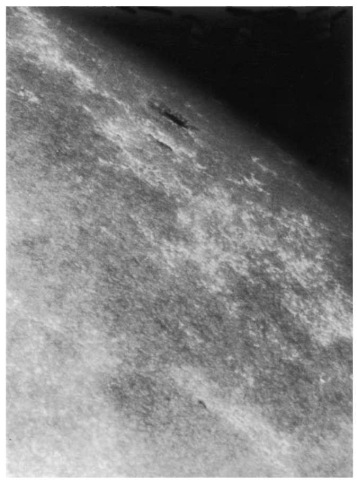
Figure 7. High-resolution image of faculae and sunspots near the limb (upper center), obtained at the Pic du Midi Observatory, France, at a wavelength of 5750 with filter of 100 A passband.
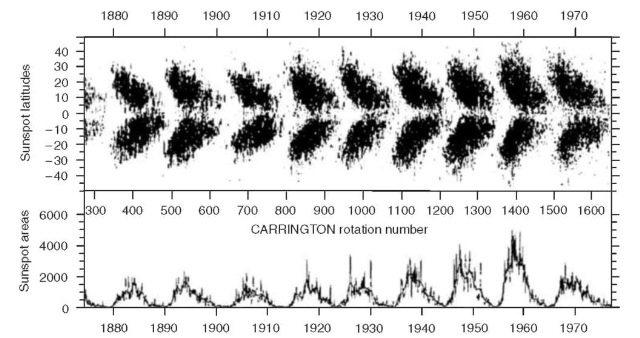
Figure 8. Butterfly diagram (compiled by J.A. Eddy) showing the drift of sunspot position toward the equator. The length of each cycle is about 12 years, causing the old and new cycles to overlap (HAO).
What about the behavior of the magnetic properties of the sunspots? If one considers a pair of sunspots in a given hemisphere during a particular sunspot cycle, the leading spot moving west will have one magnetic polarity (N or S), and the following spot has the opposite polarity, but this pattern is reversed in the other hemisphere. In the next solar cycle, the polarities are also reversed, which means that two sunspot cycles, or 22 years, must elapse before the orientation of the magnetic polarity is the same again. This characteristic of sunspots, discovered in 1912, is known as the Hale-Nicholson law. How are we to understand this fascinating behavior of sunspots?
The most obvious features of the magnetic characteristics of active regions are the strong local magnetic fields, the Hale-Nicholson polarity laws, Sporer’s law, and the 22-year magnetic cycle. Forty years ago, Horace Babcock, who developed the first solar magnetograph at the end of the 1940s with his father Harold, proposed a ”solar dynamo” model that explains qualitatively the four features just mentioned (31). The essential ingredients consist of a weak ~1-gauss solar surface field due to an axisymmetric dipole and a rotating Sun that has a convective zone that rotates faster at the equator than at higher latitudes. According to Babcock, it is assumed that the total magnetic flux for the equivalent dipole field, which extends over all space outside the Sun, is ~8 x 1021 maxwells (or ~8 x 1015 webers) and lies in a thin convective layer about 0.1 R© thick just below the photosphere. However, the current view is that the dynamo lies in a transitional region between the convective and radiative zone called the tachocline (see, e.g., References 32 and 33).
The differential rotation of the Sun with latitude has recently been determined directly by the Michelson Doppler Imager (MDI) on the SOHO satellite.
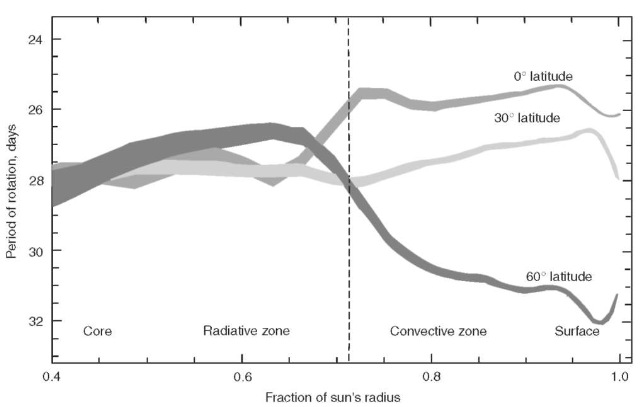
Figure 9. Internal rotational rate of the Sun at latitudes of 0, 20, and 60° has been inferred using data from the Michelson Doppler Imager on the SOHO space craft. Down to the base of the convection zone, the polar regions spin more slowly than the equatorial ones. Below the convection zone, uniform rotation appears to be the norm, although scientists have not yet determined rotational rates within the Sun’s core.
Figure 9 (from Reference 34) shows that the rotational period, as a function of the fractional radius of the Sun, in the radiative zone that extends to ~ 0.7 R© from the Sun’s center is the same at all latitudes, but in the convective zone, the period varies with latitude. The belief that the convective zone is in differential rotation is strikingly confirmed by MDI measurements. Babcock suggests that if the di-pole field is initially normal, about 3 years into a new sunspot cycle, as a result of the frozen-in subsurface field and convective zone differential rotation, ”a spiral wrapping of five turns in the North and South Hemispheres (occurs).” The field lines become stretched and twisted leading to a greatly enhanced field up to a factor of 45, depending on latitude. ”Twisting… by the faster shallow layers in low latitudes forms ‘ropes’ with local concentrations that are brought to the surface by magnetic buoyancy to produce bipolar magnetic regions (BMRs) with associated sunspots and related activity.” The essence of Babcock’s original model is shown in Fig. 10, where the opposite polarities of the BMRs in the Northern and Southern Hemispheres are clearly shown. (Excellent summaries of Bab-cock’s model, which still gives a clear qualitative picture of the magnetic cycle, may be found in References 27 and 29.)
Chromosphere and Transitional Zone. The fortuitous equality of the angular diameters of the Sun and Moon permits astronomers to see the relatively thin (~ 1500 km thick) and cool (~ 4500 K) lower atmosphere of the Sun for a few seconds before and after the total phase of an eclipse. The fact that this layer, the chromosphere, appears reddish in color is the reason that it is sometimes called the “color-sphere.” The color is due to the Balmer Ha red emission line at a wavelength of 6563 A (656.3 nm). Figure 11, based on model calculations of Vernazza et al. (35), shows a schematic diagram of the temperature versus height above the outer edge of the photosphere.4 Thus, the temperature first falls, as expected, for the first 500 km, reaches the ”temperature minimum,” and then slowly climbs to ~ 7000 K at an altitude of 2000 km, after which the temperature rises abruptly and reaches ~ 500,000 K. The region where the thermal gradient abruptly increases is called the ”transition zone.” Beyond the transitional region is the corona where the temperature continues to rise above a million K. Actually the beginning of the chromosphere is defined as just above the ”temperature minimum” where the temperature rises relatively slowly until the rapid rise. Note that the abcissa is reversed and height increases to the left.
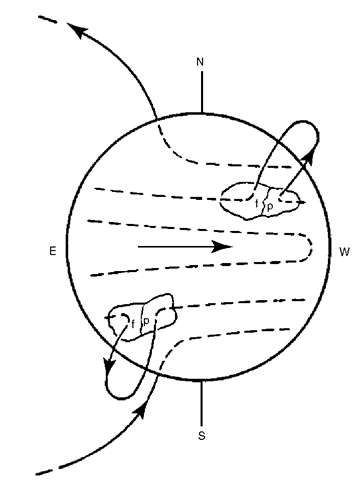
Figure 10. Bipolar magnetic regions (BMRs) are formed where buoyant flux loops of the submerged toroidal field are brought to the surface after several solar rotations have twisted the original global field. The BMRs continue to expand, and flux loops rise higher into the corona.
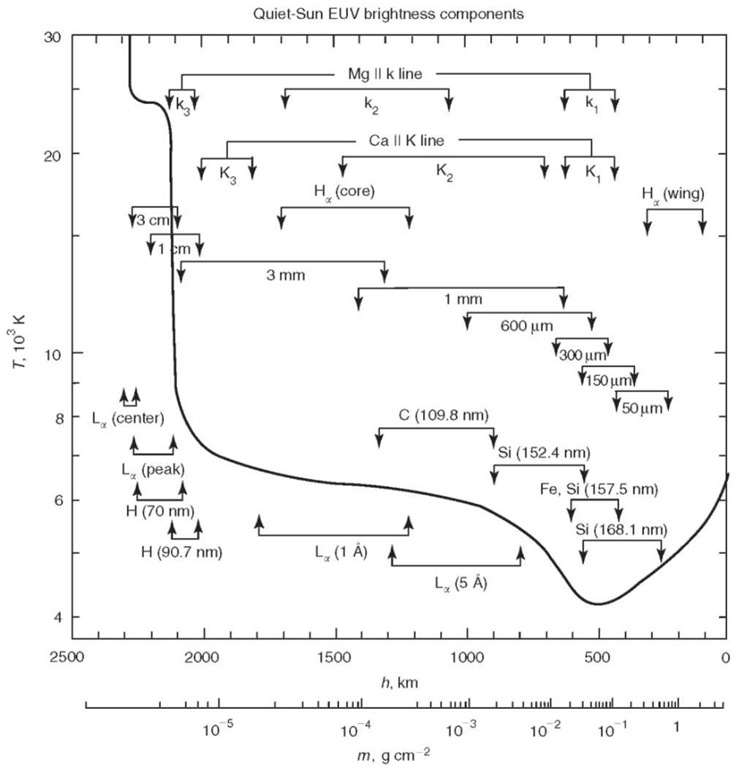
Figure 11. The average quiet-Sun temperature distribution in the chromosphere and transition region derived from the EUV continuum, the La line, and other observations. The approximate depths where the various continua and lines originate are indicated.
Figure 11 also shows the approximate region in the chromosphere where different emission features arise. Remember that when looking at the solar disc, the strong Fraunhofer absorption features from the photospheric continuum that pass through the chromosphere are dominant in the solar spectrum. Conversely, during a total solar eclipse, viewing the chromosphere at the limb reveals a beautiful spectrum, the ”flash spectrum,” devoid of Fraunhofer dark lines. This now becomes an emission spectrum, which enables studying the composition of the chromosphere. Actually the full interpretation of the flash spectrum is very complex and a treatment in depth is given in Zirin (30). At higher altitudes above the limb, unusual “coronium” lines are seen which were eventually identified as lines from highly ionized Fe and Ca. (These lines are discussed in the next section on the corona.)
When observed in the red Ha line of hydrogen, for a few seconds during a solar eclipse, one can see prominences and spike-like jets called spicules. These features are always present above the solar surface but cannot be seen against the bright disc. The spicules can extend up to 10,000 km above the solar limb, have a thickness of about 900 km, and typically move upward at velocities of ~25km/s with lifetimes of ~5min. They are concentrated at the edges of the supergranulation cells. Of course, the immediate question concerning the chromosphere is how it (and the corona) can reach the higher temperatures shown in Fig. 11. The corona can also be observed in the absence of a solar eclipse using coronagraphs on Earth or in space.
Corona. During a total solar eclipse, depending on the phase of the solar cycle, the light that extends well beyond the disc and the narrow chromosphere takes on different forms and is typically as bright as the full Moon (~ 10 ~ 6 of the sun’s brightness near the chromosphere falling to ~10 ~8 at ~2RQ. This ”crown” of light is called the solar corona. The most dramatic characteristics of the corona are its high temperature and its extremely low density, surprising for such a luminous object. The changing forms of the corona are associated with the sun-spot cycle and the changing magnetic structure. Near the minimum solar sun-spot number, the coronal intensity near the poles is depressed relative to that when the solar activity is high.
The corona, observed during an eclipse, emits a continuous spectrum similar to the photospheric continuum but has no Fraunhofer lines and instead bright emission lines, first observed in 1869. It is believed that the continuous spectrum is due to the scattering of the disc continuum from free electrons (Thomson scattering). The lines, it was thought, are from a new element, ”co-ronium.” Then in 1941, Grotrian and Edlen identified the lines as ”forbidden” transitions from highly ionized atoms such as Fe X, Fe XIV, and Ca XV, which require million degree temperatures. So the increasing temperature of the solar atmosphere above the temperature minimum reaches a few million K—more than two orders of magnitude hotter than the photosphere. This surprising fact has yet to be explained. Several mechanisms have been suggested, but from 1948 until the late 1970s, sound waves produced by the material motions in the convective zone, it is believed, produce supersonic shock waves that have sufficient energy to heat the corona. However, space-based observations did not detect any shock motions at the lower edge of the corona; presumably, if the shocks are produced outside of the photosphere, they dissipate all of their energy in the chromosphere, explaining the temperature rise seen in Fig. 11. Alternative mechanisms all seem to involve ways of transforming magnetic field energy to heat in a low-density gas, and there is at least circumstantial evidence for an analogous mechanism. This comes from the Einstein Observatory observation of intense X-ray (therefore, hot) coronas around dwarf K and M stars, which may have strong magnetic fields, because large star spots have been detected on their surfaces. Therefore, it would be reasonable to expect that the Sun’s corona could be heated in a similar manner. (A very readable description of attempts to explain coronal heating is found in Reference 29.)
![]()
rona) from the photosphere are visible. This is the near-Sun enhanced ”zodiacal light” produced by dust in the interplanetary medium.
The corona is now studied in EUV and X-ray wavelengths from space using sounding rockets and satellites. The SKYLAB mission in 1973 obtained soft X-ray images of the inner corona that showed bright loops outlining magnetic field lines that connect opposite magnetic poles of a bipolar magnetic region.
Solar Wind. We understand today that the solar wind (SW) is the dynamic expansion of the Sun’s hot, ionized corona, a plasma that moves radially away from the Sun at a speed of ~400km/s and extends throughout the helio-sphere beyond Earth. The study of certain tails of comets led Ludwig Biermann in 1950 (36) to propose “solare korpuskular-strahlung” as the explanation for the deflection of their tails5 in the radial direction away from the Sun. This proposal credits Biermann with discovering the SW because we now know, from direct measurements in space, that it is composed predominantly of electrons, protons, alpha particles, and other ions from the Sun. The helium abundance of ~ 4-5% is apparently enhanced in the corona compared to the photosphere.
The SW has been studied intensively since the first space probes and planetary missions were launched. Its properties are continuously monitored by instruments on several spacecraft beyond Earth’s influence. The SW plasma properties vary with solar activity; the low speed and high speed winds have speeds of 327 and 702km/s, respectively. For the average SW (speed ~468 + 116km/s), the average flux of ions, directed radially away from the Sun, is ~4 x 108 particles/cm2 s at 1AV. The temperatures of the principal SW constituents, protons, electrons, and alpha particles, determined in the frame of the bulk plasma motion, are 120,000, 140,000, and 580,000 K, respectively. The alpha-particle abundance is highly variable in association with transient energetic particle events.
An important feature of the SW, directly associated with the Sun’s large-scale magnetic field, is the variability of its magnetic field. In particular, the radial component of the interplanetary magnetic field, swept out by the SW, switches polarity several times as the solar rotation sweeps the field past Earth in ~27 days (the synodic period of the Sun’s rotation, i.e., relative to Earth.) indicating sectors of opposite polarity. The field lines of opposing directions, it is understood, are separated by a thin current sheet, lying approximately in the plane of the ecliptic, which is warped, so as the Sun rotates, the alternating polarities are seen. The sectors of opposite magnetic polarities are referred to as the ”sector structure” of the interplanetary magnetic field.
The pioneering work in developing a theoretical model for the SW was done by Eugene Parker (37). See also Parker (38). He assumed that the SW was driven by the thermal pressure of the hot coronal gas. The plasma in the corona is sufficiently hot that it is not gravitationally bound. This mechanism appears sufficient to account for the low-speed SW, but not for the high-speed SW. On the other hand, the origin of the high-speed SW seems to be directly associated with coronal holes. However, the origin of the SW is still not fully understood, and this remains one of the major areas of investigation in solar physics along with heating of the corona. (A detailed treatment of the solar wind can be found in Reference 27.)
Coronal Holes. Apparently, coronal holes were first observed by X-ray telescopes carried on early sounding rocket flights. In 1973, a telescope on SKY-LAB photographed the full solar disc in soft X rays (< 1 keV). The image obtained (see Reference 39 for an impressive example) showed bright emission over and above most of the disc that extended into the corona. However, near the central meridian, a dark region extended from pole to pole. The impressive feature observed was a large coronal hole, a part of the corona, which is slightly cooler
![]()
generally cover the largest area of the corona are due to hot, X-ray emitting gas confined to closed magnetic loops whose foot points are anchored in the photosphere at bipolar magnetic sites or at more complex magnetic sites. The magnetic field lines of coronal-hole regions are open, that is, only one end of a line is tied to the photosphere at a unipolar magnetic site, and the field at several solar radii presumably becomes effectively radial, tied to the solar-wind flow. Using X-ray photographs of coronal holes and measurements of the magnetic fields at the photosphere, the high coronal magnetic field geometry is computer modeled, assuming that there are no electric currents above the photosphere, that is, that the coronal field is potential. When high-speed SW flows are extrapolated back to the Sun along field lines, it is found that the magnetic polarity of the stream in space corresponds to that of the coronal hole at the Sun. So the source of the high-speed SW is a coronal hole!
As mentioned before, the Parker model of the SW assumes that it is driven by thermal pressure, but that is not sufficient to accelerate the fast SW. One possibility is the presence of Alfven waves that propagate along magnetic field lines and can, if sufficiently intense, carry the plasma along to form the fast SW.
Another point of historical interest is that some geomagnetic disturbances (e.g., cosmic-ray variations) due to enhanced particle fluxes at Earth recurred in a 27-day period. ”M regions” on the sun were hypothesized as the source of the corpuscular radiation that causes the disturbance (see Reference 40). These regions are now identified as low-density coronal-hole regions near the sun. (A detailed discussion of this topic and its connection to the SW can be found in Reference 41).
During the first orbit of the Ulysses mission, 1992-1998, Keppler (13) in a recent review reports that there was minimal solar activity so that large polar coronal holes were present and the Solar Wind Isotopic Composition Spectrometer (SWICS) observed fast SW at speeds of 750-800 km/s at the higher latitudes. When Ulysses was at lower latitudes, above the so-called ”streamer belt,” the slow SW at speeds of 300-450 km/s was observed, consistent with the view that it arises from closed magnetic regions. Apparently, polar coronal holes ex-

period. It is interesting that the boundary between the slow and fast SW is sharp and occurrs within < ~2° of latitude. The SWICS instrument has also shown that the chemical compositions of the regions are different (42). The Ulysses instruments provide considerable data on the properties of the Interplanetary Medium (IPM), particle acceleration in so-called ”co-rotating interaction regions,” and the ”anomalous cosmic rays.” Some of these topics are reviewed in Keppler (13). The Ulysses mission will continue until at least 2001, so we can expect many more valuable results related to solar activity and phenomena in the IPM. (See the section on Space Weather, in this article.) Solar Activity. Solar activity has traditionally referred to dynamic and transient changes in photospheric active regions, where faculae, filaments, plages, and sunspots are seen. Even solar flares, historically the most dramatic symbol of solar activity, result from subtle changes in loop magnetic fields coupled to the photosphere. Within the past 30 years, vast eruptions have been observed in which 20 billion tons of matter have been expelled from the sun in a single event, a coronal mass ejection (CME), that sometimes has disastrous effects on Earth. All of these phenomena result from what might more appropriately be called solar magnetic activity. Great advances have been made in understanding the causes of solar activity, but major new missions will be necessary to unlock the secrets of this aspect of the Sun. We will first discuss some important properties of flares in the next section and then, more briefly, CMEs near the Sun.
Solar Flares and Prominences. In 1859, an intense brightening was observed near a large sunspot group by English observers Carrington and Hodgson; it was the first recorded report of a solar flare, or what is sometimes also called a solar eruption (see Reference 43 for an early history of astronomy). We know now that this type of transient event, which usually can last for minutes or hours, is caused most certainly by the release of energy that resides in the strong magnetic fields that are present in a plage/sunspot region. Before discussing the possible cause of solar flares, some of their general properties must be presented. First, a solar flare is the most energetic transient phenomenon that takes place in the solar atmosphere; the largest releases as much as 1032 ergs overall, although CMEs may release a comparable amount of energy. This is more than 2 billion times more energy than is released in a 1-megaton nuclear explosion. In addition, it is now known that a large flare emits a major fraction of its energy as electromagnetic radiation (photons), ions, and electrons. The photon energies range from about 10 microelectronvolts (meV) for meter-wave radio emissions, to electron volts, for optical emissions, and to a billion eV (GeV) for gamma rays. Major flares can produce both ions and electrons that have relativistic kinetic energies, as well as relativistic neutrons, that can reach Earth. The frequency with which flares occur follows the sunspot cycle and, as mentioned earlier, the more flares occur, the larger the total area of sunspots.
Because the intensity of flare emissions appears roughly proportional to the area of the flare in the optical region of the electromagnetic spectrum, solar astronomers have developed a classification scheme to report on the ”importance” of a flare. In particular, flares are routinely observed in the light of the red Balmer line of hydrogen, the Ha line whose wavelength is 656.3 nm. Now, the microwave radio flux and the soft X-ray intensity are also routinely measured as well. Table 5 (from Reference 30) shows the classification scheme used to report the properties of an optical flare developed by the International Astronomic Union (IAU) in 1966. The first and second columns in the table refer to th observed area of the enhanced Ha emission region in terms of square degrees o the solar surface6 in the heliocentric coordinate system (column 1) or in mi lionths of the area of the solar hemisphere (column 2), and the third defines th optical class of the flare.
Table 5. Flare Classification by Areaa

Sometimes a letter, f, n, or b, follows the letter class indicating that th estimated visual brightness is faint, normal or bright, respectively. The fourt

In the flare literature, there are numerous different types of flares depending on their shape or what technique is used for observing, but in Ha, the designations compact and two-ribbon seem sufficient (44). Generally, flares occur in magnetic loops or flux tubes whose foot points are rooted in, or near, sunspots. Compact flares are small and apparently have a single loop, whereas two-ribbon flares are much larger and have two bright ribbons moving away from a single dark ribbon or filament. When viewed on the disc, a prominence appears as a dark filament. The larger flares can last for hours, and the brightest are seen as white light flares. The Ha flare is often called a chromospheric flare, or “cool” flare, as contrasted to the “hot” flare that occurs in the corona at a temperature of ~107K. (See an extensive discussion in Reference 45).
It is instructive to see a flare in a wavelength other than in the standard Ha band; and both sounding rocket and satellite images are readily available now. On 11 September 1989, a sounding rocket carrying a high-resolution X-ray telescope, NIXT (Normal Incidence X-ray Telescope, the forerunner of TRACE), observed the solar corona in a narrow wavelength band centered at 6.35 nm, which includes X-ray spectral lines from highly ionized Fe XVI and Mg X atoms.
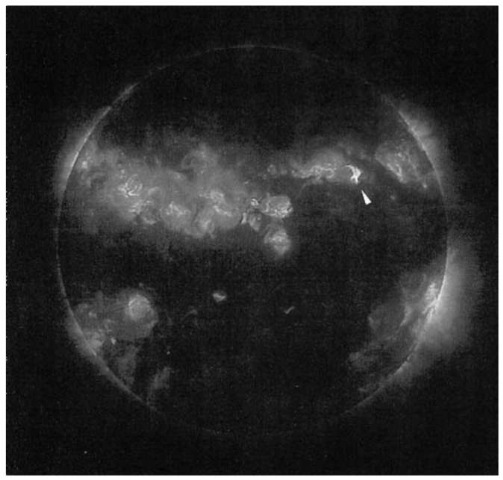
Figure 12. A high-resolution X-ray image of the solar corona that has active regions and a flare (indicated by the arrow). The angular resolution is 0.75″, and the temperature of the brightest areas is about 3 x 106 K. This image was made by L. Golub et al. in 1989 from a rocket using the 0.25-m X-ray telescope NIXT (Normal Incidence X-ray Telescope) in a narrow wavelength range around 6.35 nm; this range includes the emission lines of Fe XVI at 6.37/6.29 nm and of Mg X at 6.33/6.32 nm. In contrast to an image-forming X-ray telescope of the Wolter type that has grazing incidence, here the image is produced at normal incidence as by an orinary optical mirror. Reflection of the X rays is made possible by vapor deposition of alternating thin layers of cobalt and carbon, so that constructive interference results for the wavelength 6.35 nm. NIXT was developed by L. Golub and co-workers at the Smithsonian Astrophysical Observatory. Cambridge, together with the IBM Thomas J. Watson Research Center, Yorktown Heights, New York (photo courtesy of SAO and IBM Corp.). (See Reference 46 for description of rocket flight.)
The coronal temperatures required to produce these lines is in the range of a few million degrees (~107K). The image obtained is shown in Fig. 12 (from Reference 46) and shows the full solar disc where bright emission is across the several active photospheric regions. In addition, the most intense feature, northwest7 of the Sun’s center is a small two-ribbon subflare, SbC5, so the soft X-ray intensity is 5 x 10 ” 6W/m2 in the 10- to 80-nm band. This flare was observed by NIXT 2 minutes after the GOES monitoring satellite observed the peak of the X-ray emission and, judging from its brightness compared to the coronal emission across the several active regions, its temperature is probably 107 K. What is particularly interesting and significant about this observation is that the tangled coronal structure, controlled by the local magnetic fields, is undoubtedly due to similar magnetic complexity in the active photospheric regions.
The basic question of what causes a flare is still unanswered, but optical and magnetic observations of active regions and the morphology of two-ribbon flares have led to the general view that reconnection, or annihilation, of opposing magnetic fields occurs in an “arcade” of magnetic loops that are anchored in the photosphere. It is also now believed that the energy release occurs in the corona and there is adequate energy stored in sunspot magnetic fields so that only a small fraction of the existing fields need be annihilated to supply the energy for a major flare. (See the next section for a specific example—the Masuda flare.)
There is a vast literature on solar flares that was developed before the space age began, and key observations of their electromagnetic emissions were made by both ground-based optical and radio telescopes. Much of the early and current knowledge about flares is expertly treated by Zirin in Astrophysics Of The Sun (30) and earlier by Svestka in Solar Flares (47). Recent discussions may be found also in Tandberg-Hanssen and Emslie (48) and Somov (49).
High-Energy Flare Emissions. A singular event occurred in 1942, when several cosmic-ray detectors on Earth responded to an increased flux of particles, presumably produced in association with an intense flare that occurred 2 days earlier. If the increased ground-level cosmic-ray flux was due to protons at the top of the atmosphere, then the protons must have relativistic kinetic energies. This ”solar flare effect” in ground-level high-energy cosmic-ray detectors recurred about every 4 years until after WWII, when cosmic-ray groups around the world began carrying instruments to high altitudes on balloons and the so-called solar cosmic rays could be studied at lower energies using other instruments. It is this aspect of solar flares that is most important to focus on because high-energy flare emissions produce the greatest effects on Earth and on spacecraft. Recognition of this fact led in 1963 to a major conference on ”The Physics of Solar Flares” at the Goddard Space Flight Center (see Reference 50). This article concentrates mainly on recent results obtained from SMM, YOHKOH, CGRO, SOHO, and TRACE after some brief history. (See Reference 11 for a review of results from 1942-1995.)
The dramatic increases in ground-level cosmic-ray intensity are often referred to as ground-level events (GLEs), enhancements of the count rate of a cosmic-ray intensity monitor. The first GLE observations were made using ionization chambers and Geiger-Mueller counters that detect predominantly the charged secondary components produced in the atmosphere by a spectrum of energetic extraterrestrial particles. After the end of World War II, neutron monitors were developed that respond to the secondary nucleonic component produced by the lower energy particles in the spectrum incident at the top of the atmosphere. See Simpson (51) for a detailed discussion of this subject. Using this new technique, on 19 November 1949, a GLE was observed after a large solar flare. The intensity recorded during the maximum of the event was six times the normal value, a relative increase, which was considerably larger than those of earlier bursts.
Major activity in the early part of 1950 was low; then on 26 February 1956, a large GLE occurred. This event became a powerful stimulus to research on high-energy charged particles and photons associated with solar flares. The neutron monitor increase showed that protons that had energies > 15-30 GeV were produced in close temporal association with the flare optical and radio emissions. The protons that caused this GLE, it was believed were accelerated by the ”Fermi mechanism” in the turbulent magnetic field produced by the chromo-spheric solar flare.
The first observations of energetic photons from a solar flare were made on 20 March 1958 from a balloon-borne experiment. These detector increases coincided exactly with the maximum intensity of the optical flare (which began 5 minutes earlier) and with an 800 MHz microwave radio burst! Analysis of the individual detector rates indicated that the burst was caused by bremsstrahlung from ~ 1035 electrons that had energies of ~ 0.5 MeV.
After the USSR launched Sputnik, (4 October 1957) and the US satellite program was initiated, Morrison (52) published a stimulating paper predicting the fluxes expected for gamma-ray emission from several celestial objects and other phenomena, including solar flares. Also in the post World War II period, the systematic study of radio emission associated with solar flare ”eruptions” began. By the mid-1950s, radio spectrographs were observing solar radio bursts. Eventually, interferometers were added, that could give the spatial locations of the sources, and a concrete picture of the cause of the radio phenomena developed. This led in the 1960s to a two-phase model that explained that the radio bursts are due to accelerated ~ 100-keV electrons followed in large flares by Fermi acceleration of protons and electrons to very high energies; this explained the GLE events and the low-energy, flare-associated protons detected by satellite, balloon, and riometer (relative ionospheric opacity meter) detectors. As will be discussed, this model existed until the 1980s before new observations complicated the picture.
In the decade 1970-1980, the successful series of OGO and OSO satellites continued solar observations. Experiments on SKYLAB as well as rocket and balloon experiments were dedicated to study the Sun. Instruments on High Energy Astronomical Observatories HEAO-1 and HEAO-3, dedicated to cosmic observations, could also record high-energy solar emissions. In the early 1970s, the University California San Diego (UCSD) group’s X-ray spectrometers on the OSO 7 satellite obtained, copious X-ray observations in the range of 2-300 keV.
An auspicious development in this period was the appearance of the complex active region (McMath 11976) on 11 July 1972 that heralded the occurrence of the August 1972 series of major flares that had concurrent intense high-energy emissions and associated terrestrial effects. On 2, 4, and 7 August 1972, major flares from a single active region produced the most intense and long-lasting radiations across the full electromagnetic spectrum observed until then that had associated, intense, long-duration charged particle fluxes in space. Fortuitously, during a 10-minute period in the rising phase of the 4 August flare, the OSO 7 gamma-ray spectrometer recorded, for the first time (53), an intense gamma-ray line and continuum spectrum, that dramatically confirmed the 1958 prediction by Morrison (52) that nuclear reactions in the solar atmosphere during flares could produce a 2.223 MeV line detectable on Earth. The spectrum obtained also gave evidence of nuclear lines at 0.511 MeV, 4.4 MeV, and 6.1 MeV and continuum photons to 10 MeV. The ground-based optical observations of the two-ribbon flares on 4 and 7 August are discussed in detail by Zirin (30).
These observations implied that acceleration of protons above 30 MeV was closely associated with the production of the relativistic electrons that produced the bremsstrahlung continuum. This concept was not taken seriously though, probably because of the 3-minute time resolution of the observations. Therefore, the two-phase model, mentioned before, was still considered valid. Also, based on the published OSO 7 data, Svestka in his 1976 monograph on solar flares (47) proposed for the first time that electrons and ions were accelerated in the ”same (one-step) acceleration process, or that the second-step acceleration (giving rise to > 30 MeV protons) immediately follows the process of pre-acceleration.”
Due to the launch of the SMM satellite on 14 February 1980 and the Japanese Hinotori satellite on 21 February 1981, the continuing International Sun-Earth Explorer/International Comet Explorer (ISSE 3/ICE) and Interplanetary Monitoring Probe (IMP) operations, and the coordinated ground-based solar observations of the Solar Maximum Year (SMY), an avalanche of new information on solar flares became available. Satellite observations by the hard X-ray and gamma-ray spectrometers on these new missions provided dramatic new diagnostic tools for determining the properties of particle acceleration associated with solar flares.
Within the first few months of flare observations in 1980 by the gamma-ray spectrometer (GRS) on SMM, it became clear that acceleration of ~50-MeV protons and relativistic electrons was simultaneous to within the instrument time resolution of 1-16 s (54), confirming the earlier suggestion of Svestka (47). Note that this observation is contrary to the two-phase acceleration model mentioned earlier.
During an intense limb flare on 21 June 1980, the SMM GRS detected, for the first time, a burst of energetic neutrons at Earth, after a 1-minute-long burst of gamma-ray lines and electron bremsstrahlung that extended to more than 100 MeV in photon energy. This confirmed the 1951 prediction (55) that relativistic protons, accelerated during a solar flare, could produce a flux of high-energy neutrons observable at Earth. Then, during the impressive east-limb flare on 3 June 1982 that produced intense nuclear line emission, it was shown (56) that the photon spectrum above 10 MeV included contributions from meson-decay gamma rays and electron bremsstralung that extended to more than 100 MeV. Neutron monitors in Europe also recorded, for the first time, secondary neutrons produced in the atmosphere by primary solar neutrons (57) (see Fig. 13). The protons that resulted from the decay of solar neutrons in space were observed by ISEE 3/ICE and IMP detectors.
Several flares observed by the SMM GRS show rich gamma-ray line spectra, from which it is possible, in principle, to determine the composition of the ambient solar atmosphere where the nuclear reactions occur. Analysis of the spectrum obtained for the 27 April 1981 flare, a long duration gamma-ray flare, indicates that the ambient medium composition differs from that of both the photosphere and the corona and requires an enhanced neon abundance. For this flare, it is suggested that significant gamma-ray line production could take place in the corona. In impulsive flares, most of the line emission is expected to peak in the lower chromosphere, and there is essentially no contribution from the corona. Figure 14 shows the spectrum for this flare calculated by Ramaty (58) that gives the best fit to the observed line spectrum. In general, the SMM GRS observations were confirmed by the gamma-ray spectrometer (GRS) on the Hinotori satellite.
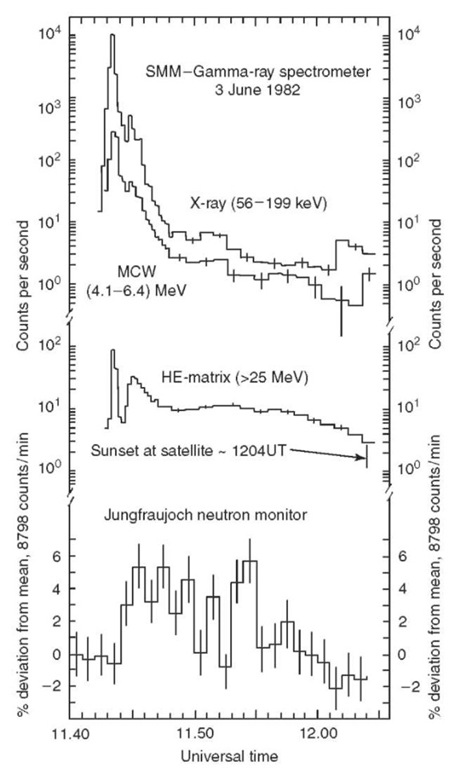
Figure 13. Temporal history for several data channels from the SMM GRS and for the Jungfraujoch neutron monitor count rate for the 3 June 1982 flare. Peak count rates in the GRS (X-ray) and MCW (4.1-6.4) MeV energy bands are uncertain because of pulse pile-up, excessive dead time, and photomultiplier gain shifts and should be used with care. The highest MCW count rates have been estimated using measured live time values, averaged over 16.384 s, and a derived gain shift correction. Error bars are based on count statistics only.
By the end of solar activity cycles 20 and 21 in 1986, all of the high-energy radiations predicted (52,59) had been observed; they revealed new insights into the solar flare particle acceleration enigma. Table 6 summarizes the principal characteristics of the emissions from high-energy solar flares. These may be considered observational constraints, which any theory of particle acceleration must satisfy. The temporal evolution of a flare may be separated into three phases: onset, impulsive, and extended phases. A particular flare may be of short duration (a few seconds or minutes) or of long duration (hours); each has emission characteristics shown in the three columns of the table. Table 7 shows the properties of the accelerated electrons and ions of the larger flares.

Figure 14. Calculated solar flare gamma-ray spectrum corresponding to abundances that best fit the observed spectrum of the 27 April 1981 limb flare.
After the demise of the SMM satellite, on 1 December 1989 the French/ Russian satellite, GRANAT, was launched and observed high-energy flare neutral emissions from two flares on 15 May, 24 May, and 11 June 1990. The Russian spacecraft GAMMA-1 provided the only gamma-ray data available on the intense flare at 20:28 UT on 26 March 1991.
Since April 1991, additional solar flare observations were made by the four instruments on the Compton Gamma-Ray Observatory (CGRO). All CGRO instruments directly viewed three X-class flares on 9, 11 and 15 June 1991. Because the instruments on the CGRO, particularly, were much larger than those on the SMM and Hinotori, extended, hours long emissions of gamma rays and neutrons at low flux levels could be identified following some of these flares. The most dramatic example of extended emission was obtained by the CGRO EGRET, following the 11 June 1991 flare when high-energy gamma rays (> 100 MeV) from meson decay and ultrarelativistic bremsstrahlung were observed continuing more than 8 hours after the peak of the flare (60). The PHEBUS spectrometers on GRANAT also recorded gamma-ray line and continuum emissions throughout the intense part of the flare when the EGRET spark chamber and the COMPTEL were disabled because of electronic dead time caused by intense X-ray flux in anticoincidence shields. The EGRET Total Absorption Spectrometer Calorimeter (TASC), however, could also function independently of the spark chamber, so high-energy emissions were recorded throughout the flare. After the intense phase of this flare, analysis of the COMPTEL data indicated a flux of neutrons in the energy range of 40-60 MeV, and the EGRET TASC also showed possible evidence of even higher energy neutrons. Figure 15, from Dunphy et al. (61), shows the energy loss spectra in the EGRET TASC for several time intervals during this long event. Phases I-1 and II correspond to the impulsive and extended phases listed in Table 6.
Table 6. Observational Constraints for Acceleration Theory of Temporal Evolution3
| [I.] Onset phase | [II.] Impulsive burst | [III.] Extended emission |
| Duration is typically minutes | Sudden enhancement of bremsstrahlung to several hundred MeV | Impulsive events with simple decay |
| Brightening occurs in UV, soft X rays, or Ha | Simultaneous enhancement of g-ray line emission |
Impulsive event and continued production of high-energy emissions |
| Type III burst at coronal height b(0.4 – 1)RG | Occasional bursts of > 10 MeV photons | Succession of impulsive events and g-ray line emission dominant over bremsstrahlung |
| Type I noise storms Increasing intensity of hard X-ray bremsstrahlung |
Emission of decay g rays Arrival of high-energy neutrons at Earth ~10MeV<£n>2GeV |
Succession of impulsive events bremsstrahlung dominant over g-ray line emission |
| Low-level g-ray line emission develops | Production of escaping particles (SEP)? |
|
| Bursts of > 10 MeV photons sometimes occur | ||
| New radio sources appear as new energetic emissions appear | Type III/V radio burst | Type II and IV radio bursts |
Two important questions posed by the long-term high-energy gamma-ray emission concern the acceleration mechanism/geometry and whether the particles are accelerated in a short impulsive phase that lasts a few minutes, are trapped in magnetic loops, and subsequently precipitate into the lower corona. Or are the particles continually accelerated by processes other than that which produced the particles causing the initial burst of high-energy radiation? The first possibility was considered by Mandzhavidze and Ramaty (62), who concluded that the trapping model can explain the observations. The second possibility has been considered in interpreting the GAMMA 1 and COMPTEL data for the 15 June 1991 flare. Electric fields produced in a reconnecting current sheet (behind a rising CME) accelerate the ions and electrons and explain, particularly, the delayed microwave emission, the 1- to 8-MeV and 100-MeV, and 1-GeV gamma rays. An earlier analysis of essentially the same data concluded that the delayed (gradual phase) emission resulted from prolonged production due to stochastic acceleration. Further interpretations of flares from AR6659 and the question of storage or continuous acceleration of charged particles have recently been reviewed (63).
Table 7. Some Extreme Particle Properties3
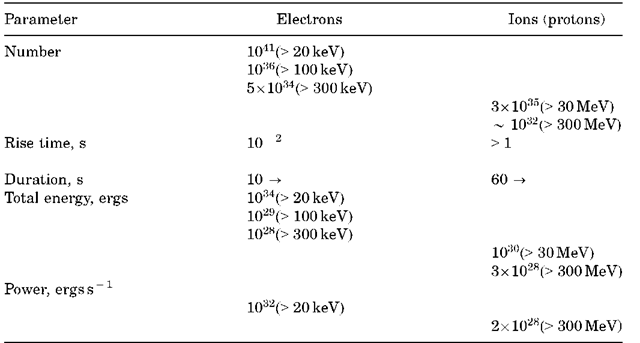
The high-energy flares discussed before were observed by using nonimaging instruments, so the actual location of gamma-ray and neutron source regions is unknown. However, imaging of relatively small regions on the Sun is possible at photon energies below 100 keV. Due to the launch of the Japanese solar observing satellite YOHKOH and its soft X-ray telescope (SXT) and hard X-ray telescope (HXT), flare observations have been revolutionized. On 13 January 1992, these two telescopes took images of a compact M2.0-class X-ray flare on the west limb. Figure 16 shows a schematic of the flare geometry as deduced from the SXT and HXT images given in Masuda et al. (64). The SXR loop represents the SXT image at ~2keV, and the three features marked HXR correspond to the major emissions recorded by the HXT above ~ 25 keV. The flare in X rays below ~ 33 keV was of 1-minute duration or less. The image in hard X rays shows the loop top source ~ 700 km above the top of the SXR loop, and it is believed that the former is the site of acceleration of the electrons that stream down the two sides of the SXR loop and produce the HXR foot-point sources. The hypothetical magnetic field geometry above the loop top is based on observations of two-ribbon flares (65) and is consistent with the view that energy release in a coronal current sheet due to magnetic reconnection produces downward (and outward) moving shocks, which can both heat material in the loop top to temperatures as high as 2 x 108K and accelerate nonthermal electrons. Figure 17 shows an SXT image of a major X9 ”behind the limb” flare that has major emission above the limb in the corona.
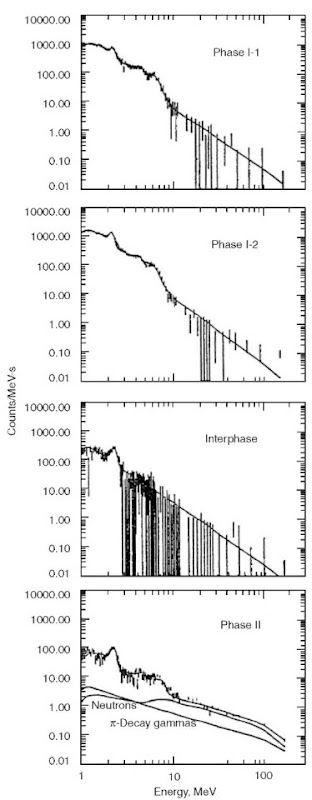
Figure 15. Plots of energy-loss spectra (background subtracted) observed by the TASC for several time intervals during the 11 June flare. The spectra were fit with a multi-component model spectrum described in the text.

Figure 16. The magnetic-field geometry for reconnection derived from the present observation. The important features are elongated antiparallel magnetic fields above an arcade of closed loops; a current sheet (or neutral sheet) formation between them and the reconnection point impinges on the underlying closed loop and forms a shock, resulting in a high-temperature (Te~2 x 108K) region just above the closed loop. It is also likely that electrons are accelerated in the shock and stream down along the reconnected field toward the double foot-point sources.
This observation has stimulated further theoretical and interpretive research to understand this type of flare, which may be fundamental for all flares. Recently, Forbes (66) studied possible trigger mechanisms for both solar and stellar flares and concluded that it is likely that both ”involve the sudden release of magnetic energy” via reconnection but there may be different trigger mechanisms involved simply because the magnetic field structures are probably not the same. In flares, the ”trigger” causes a loss of stability, or equilibrium, in a coronal magnetic field configuration and could be due to new magnetic flux that emerges from the photosphere or twisting of field lines tied at foot points. Either would produce stresses in the field that increase to a limit above which equilibrium is lost.

Figure 17. SXT images of the X9 event of 2 November 1992 as the sum of the raw white light and soft X-ray images at about 03:18 UT. The contours show the location of the limb. The flare occurred about 10° behind the limb and was the largest of the Yohkoh eta. By Hugh Hudson.
Coronal Mass Ejections. During satellite missions in the early 1970s, particularly during OSO 7 and the SKYLAB observations, bright transient features that moved rapidly away from the Sun were seen in the corona. These events, which are called coronal mass ejections (CMEs), were observed using white light coronagraphs, which occult the bright disc emission, making an artificial eclipse. They are made visible by scattering, toward the observer, of the photospheric continuum by free electrons (Thomson scattering) from the leading edge of the feature. This technique permits observing the corona from about 2-30 solar radii (R©) from the center of the Sun. CMEs have speeds, measured by the projected position of the leading edge versus time, which range from <50 to ~2000km/s, and estimates of the total mass involved are ~1012 to 1014kg. CMEs are actual expulsions of matter and magnetic fields from regions lower in the solar atmosphere. Such features are sometimes called coronal transients.
The most recent studies of CMEs have found that they are more frequently associated with eruptive prominences than solar flares. The sudden disappearance (or disparition brusque) of filaments, it is believed, is associated with most CMEs (30). In Figure 18 is shown a recent SOHO image, made by its Extreme-Ultraviolet Imaging Telescope (EIT), of an eruptive prominence on the west solar limb. Presumably the CME that would be associated with such an eruption would lift offfrom the Sun because the matter is no longer tied to the Sun by the magnetic field of the preexisting prominence. The cause of such eruptions is not known at the present time (30).
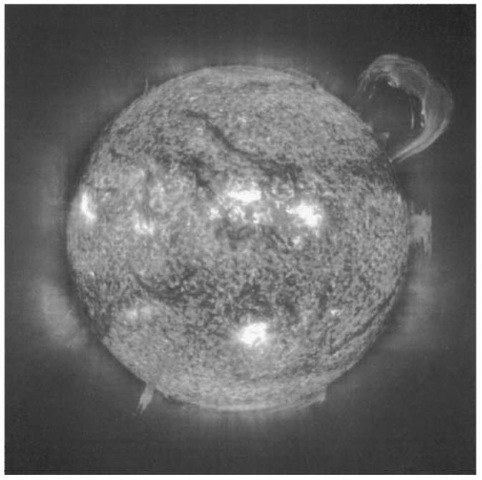
Figure 18.This EIT full Sun image, taken on 14 September 1999 in the He II emission line at 304 A shows the upper chromosphere/lower transitional region at a temperature of about 60,000 K. The bright features are called active regions. A huge erupting prominence escaping the Sun can be seen in the upper right part of the image. Prominences are “cool” 60,000 K plasma embedded in the much hotter surrounding corona, which is typically at temperatures above 1 million K. If an eruption like this is directed toward Earth, it can cause a significant amount of geomagnetic activity in Earth’s environment and a following spectacular aurora. Instrument: EIT; Taken; 14 Sept 1999, 07:19UT.
Studies have also shown that flares are not always associated with CMEs and sometimes the flare initiation lags the projected time of the CME onset. The CMEs that have speeds in excess of ~600km/s are potential drivers of shock waves moving through the interplanetary magnetic field, and it is believed that acceleration of energetic particles to GeV energies can occur at the shock front. One proposal is that all of the long duration, or energetic gradual, particle events seen at Earth that produce GLEs are caused by particles accelerated by CME shocks. This is actually a very controversial subject because all of the major GLEs at Earth are also associated with major solar flares. As discussed earlier, it is known that GeV ions and electrons are accelerated in a solar flare. Major advances in studying CMEs are currently in progress using the Large Angle Spectroscopic Coronagraph (LASCO) on the SOHO spacecraft. Further discussion of CMEs may be found in Kahler (67).
Coronae Of Solar Type Stars. It might be surprising to find that activity on some solar-type distant stars, ~ 42 light years away compared to the Sun’s distance of 8 light-minutes, should be observable from near Earth. The photon flux in any wavelength band would be reduced by a factor of ~ 1014 from such a star, compared to the Sun. So-called flare stars have been observed by astronomers (professional and amateur) at visible wavelengths since stellar observations have become commonplace. An important example of flare stars is the binary group known as RS Canum Venaticorum (68), whose discovery is closely related to the discovery of starspots (68). The appellation, ”flare stars,” was given to this type of star because transient emission was similar to the optical intensity variation (in Ha) seen in solar flares. Flare stars have also been seen at radio wavelengths since the late 1950s and also at ultraviolet and X-ray wavelengths (see later and also References 69 and 70). In 1974, a rocket observation was made of Capella, an RS CVn variable, by Catura and Acton at soft X-ray wavelengths. This object was identified as a member of ”a new class of galactic X-ray sources.” It is understood now that the X-ray emission is most likely associated with the degree of magnetic activity on the star, which again is related to the size of starspots on the star.
Since the Einstein Satellite’s study of X-ray stars (71) and more recently, using ROSAT data, astronomers have studied the X-ray luminosity of stars ranging in size from giant stars to main sequence and subgiants. Because it is believed that the magnetic activity of the Sun, represented by the number (or total area) of sunspots on the Sun (see Fig. 8), is due to the action of the solar dynamo that results from the differential rotation of the sun, it is believed that the intensity of stellar X-ray emission could be related to the observed rotational speed of the star. This correlation of the X-ray luminosity of a variety of stars with known rotational speeds is shown in Fig. 19 from Pallavicini et al. (71) and has been confirmed in a recent study by Haisch and Schmitt (72). This result also can be understood as follows: recall in our discussion of the origin of sunspots, that two factors were essential: differential rotation of the Sun versus latitude and the presence of a convective zone that provides the conditions for the solar dynamo and leads to the creation of sunspots, emerging magnetic flux, and solar activity in general. Now, the RS CVn binary variables are the most intense emitters of X rays, which it is thought, is related to the short orbital period of the pair about their mutual center of mass. Because the separation of the pair is relatively small, <0.3 AU, there are strong tidal forces, and the individual star’s rotational periods become synchronized with the rapid orbital motion ofthe pair. It is believed that this is the basic cause of the greater magnetic activity and hence greater X-ray intensity of this system, as shown in Fig. 19. Haisch and Schmitt (72) also discuss the recent 1995 observation of a huge X-ray flare on the binary T Tauri star, V773 Tau. The peak X-ray (0.7-10 keV) luminosity was 1033ergs/s, and the total energy release in the same energy band was 1037ergs; these values are 104 and 105 higher than the same values for solar flares. T Tauri binary star systems also rotate rapidly, not from tidal action, but because they are young stars that contract from the protostellar cloud stage. It has also been inferred that large sunspots exist in this system, so these observations give strong-support to the belief that rotation is the prime cause of their magnetic activity, that is, flaring and this idea carried to the Sun supports the theoretical model of sunspot creation as a result of differential rotation twisting a poloidal magnetic field See also Haisch 1991 (73).
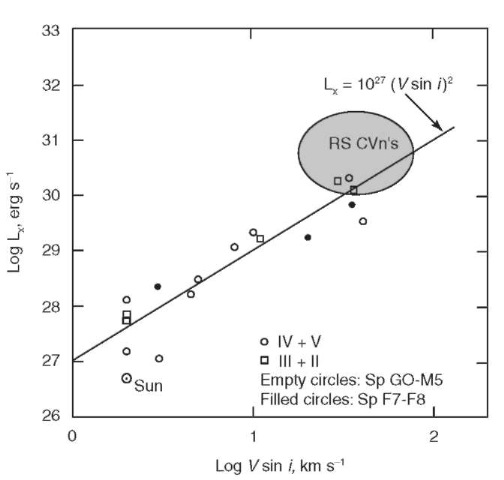
Figure 19. X-ray luminosities plotted versus projected rotational velocities for stars of spectral type F7-F8 (filled symbols) and GO to M5 (open symbols). The position of RS CVn stars in indicated.
Another important aspect of this solar/stellar connection is the necessity of convective zones for producing a dynamo. The association of coronal activity in the Sun with its magnetic activity, probably produced at the base of the convec-tive zone, is shown in Fig. 20.
Helioseismology. In 1960, Leighton, using the 150-foot tower telescope at Mount Wilson solar observatory to study the Doppler-shift motions ofFraunhofer lines over granulations, discovered that the radial velocities of certain lines oscillated in a period of 5 minutes. These were later explained, independently by R. Ulrich and R. Stein, and another solar physicist, J. Leibacher, by the superposition ofnonradial sound waves trapped in the convective zone, which acted as a resonant cavity. Many other modes of oscillation, called acoustic modes, have subsequently been discovered. Because the Sun is a sphere of hot gas, it has oscillatory amplitudes described by spherical harmonics, which are designated by eigenvalues l (angular degree) and m (azimuthal). The 5-minute oscillations now have been identified with l-values from 0 to > 1000. The modes that have small l-values (long wavelengths) can penetrate to the center of the Sun. The waves are also designated as p-modes, or pressure modes, and g-modes, or gravity modes; the latter are due to buoyancy. The g-modes have larger amplitudes and are better for investigating the Sun’s structure near the core; however, there is not yet definite evidence of their existence. Clearly, because disturbances are propagated at the velocity of sound, which depends on temperature and density, the study of solar oscillations can give information about these parameters in the solar interior.
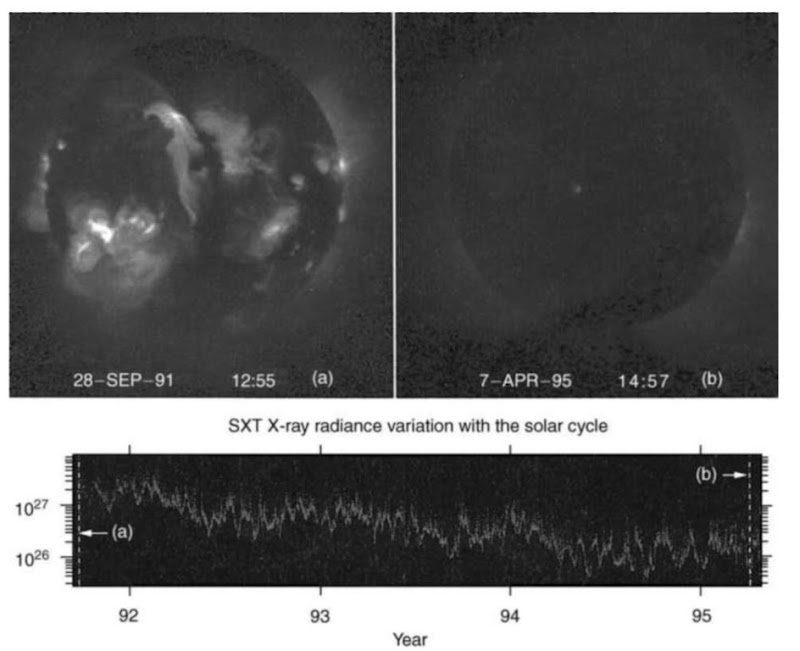
Figure 20. The violently hot solar corona is visible in X radiation. These images from the Yohkoh satellete show how the corona varies with the 11-year solar activity cycle. The bright corona at the left shows high activity, which may be associated with magnetic storms on Earth and other injurious effects. The dark corona on the right shows the present situation (ca. 1995) of low magnetic activity. The plot at the bottom shows the time variation. Activity started to increase again in 1997-1998. The solar X-ray images are from the Yohkoh mission of ISAS, Japan. The X-ray telescope was prepared by the Lockheed Palo Alto Research Laboratory, the National Astronomical Observatory of Japan, and the University of Tokyo with the support of NASA and ISAS.
Currently, the two major projects to study solar oscillations are GONG and the several instruments on the SOHO spacecraft, which were described earlier. The Global Oscillation Network Group (GONG) began operation on 5 October 1995 and consists of six solar observatories, fitted with special telescopes, which are spaced around Earth so at least one will have the Sun in its field of view. SOHO was launched on 2 December 1995, reached the inner Lagrangian point L1 on 14 February 1996, and began constant observations of the Sun. On 25 June 1998, contact with SOHO was lost, but was established again several months later.
The results of new observations from these projects have not been fully synthesized, but one important result gives the sound speed and density profiles throughout the Sun. At a COSPAR meeting in Nagoya in 1998, Shibahashi (74) listed several vital issues in solar physics that helioseismology research will impact, and we mention a few:
* Attempts to solve the solar neutrino problem will benefit by improving the SSM.
* Measuring the rotational rate of the core can aid in determining the evolution of the Sun because of conservation of angular momentum, which suggests an increasing angular velocity with age. Conversely, the surface layers are expected to lose angular momentum to the SW, so the Sun’s internal angular momentum distribution should be determined. Related to this is the differential rotational rate of the solar surface and convective zone as a function of latitude.
* The mechanism for depletion of surface lithium abundance is unknown as is the physical cause of the existence of the chromosphere and corona.
* The cause of solar activity and the energy release mechanisms and triggers for flares and CMEs is unknown. How can the change in solar luminosity with solar activity, which is connected to energy transport in the convective zone, be understood?
* Finally, helioseismologists expect to develop a model of the solar interior, independent of the evolutionary SSM.
For further reading on this fascinating subject, see References 27,29,30,74. Of most value are the web home pages:
* GONG: http://helios.tuc.noao.edu/helioseismology.html
* SOHO: http://sohowww.nascom.nasa.gov/
Space Weather. The effects of solar activity are dramatic in space and even damage or disable satellites. Sometimes the effects on Earth can affect everyday life by disrupting communications or causing electrical power outages. Major effects are caused by intense fluxes of ionizing radiation (primarily energetic protons) and intense X-ray bursts. The most damaging are the large solar energetic proton (SEP) events.
The deleterious effects of solar activity have therefore caused the development of a new business—space weather forecasting. The organization charged with this task is the National Oceanographic and Atmospheric Administration (NOAA) in Boulder, Colorado, whose Space Environment Center (SEC) issues daily reports and sends alerts of impending space storms to all who may be affected. Table 8 lists the known ”Solar Proton Events Affecting the Earth Environment” which is available on the SEC web page. Following is the SEC web address, where the reader can browse to find topics of particular interest: http:// www.sel.noaa.gov/.
1. Firm Evidence for Neutrino Oscillations. This possible solution to the solar neutrino problem was discussed in the original manuscript. Now a new neutrino detector, which began observing solar neutrinos in late 1999, provides compelling evidence that the neutrinos oscillate or change their “flavor” in transit from the solar core to the earth. (See Ahmed et al., Phys. Rev. Lett. 89, 011301 (2002) and Physics Today, July 2000).
The detector, The Sudbury Neutrino Observatory (SNO), consists of a kil-oton of heavy water in a transparent spherical shell of 12 m diameter and viewed by 9456 photomultiplier tubes. This apparatus is surrounded by a large ultra-pure light water shield and resides in a nickel mine at a depth of 6010 m of water equivalent near Sudbury in Ontario, Canada. The SNO can detect the continuous spectrum of 8B neutrinos above 2.2 MeV (see text—Fig. 4) through the reactions
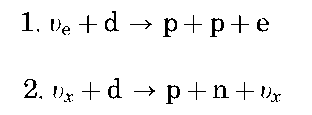
and also by elastic scattering via

Here x stands for all neutrino flavors. x = e, m, t. Reactions (2) and (3) are sensitive to all neutrino flavors while 1 is only sensitive to the electron-type neutrinos which are directly produced in the fusion reactions in the core of the sun (see text—Table 3). The essential results are

![]()
cellent agreement with the measured total flux of all neutrinos. Thus about two-thirds of the Sun’s 8B neutrinos have changed their flavor, i.e. presumably transmutated into muon (m) or tau (t) neutrinos.
2. RHESSI – A New Satellite to Study Solar Flares. On 5 February 2002, the Reuven Ramaty High Energy Solar Spectroscopic Imager (RHESSI) was launched by Pegasus XL spacecraft into a low-altitude orbit at an inclination
![]()
The RHESSI mission consists of a single spin-stabilized spacecraft. The only instrument on board is an imaging spectrometer with the ability to obtain high-fidelity color movies of solar flares in X-rays and gamma rays. It uses two new complementary technologies: fine grids to modulate the solar radiation and germanium detectors to measure the energy of each photon very precisely.
RHESSI’s imaging capability is achieved with fine tungsten and/or molybdenum grids that modulate the solar X-ray flux as the spacecraft rotates at
Table 8. Solar Proton Events Affecting Earth Environment January 1988-18 February 2000
— 15rpm. Up to 20 detailed images can be obtained per second. This is sufficient to track electrons as they travel from their acceleration sites, believed to be in the solar corona, and slow down on their way to the lower solar atmosphere.
High-resolution spectroscopy is achieved with nine cooled germanium cystals that detect the X-ray and gamma-ray photons transmitted through the grids over the broad energy range of 3 keV to ~ 17 MeV. Their fine energy resolution of about 1 keV is more than sufficient to reveal the detailed features of the X-ray and gamma-ray spectra, clues to the nature of the electron and ion acceleration processes.
The spinning spacecraft pointing at or near the Sun center provides a simple and reliable way to achieve the rotation required for the HESSI imaging technique. The RHESSI mission has already observed several flares, so considerable new knowledge about solar flares should be obtained in its nominal 2-3 year lifetime.

